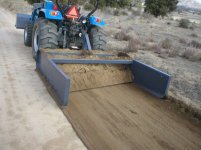jimrs
Bronze Member
The biggest difference in a land plane and a box blade is the land plane won't carry as much dirt, gravel, rock, ect. It spreads is more evenly and fills smaller indentions like washboard areas better. The box blade will carry a lot of material until you adjust the height. Thus the land plane is easier to use with less experance and seat time. Most land planes come with rippers like the box blades and are a little larger and most are a little heaver. If I had it to do again I would have bought one instead of the box blade.


